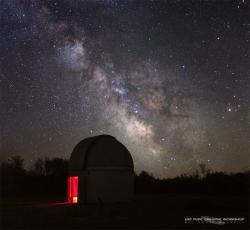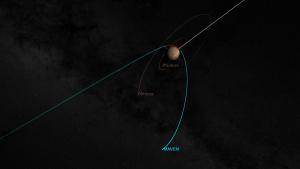
Public Stargazing
- Where:
- Frosty Drew Observatory
- When:
- Friday September 19, 2014 at 7:30 p.m.
- Cost:
- $1 Suggested Donation per Person
Tonight's forecast is calling for mostly clear conditions becoming partly cloudy over night. The 12% waning crescent Moon will rise at 3:11 a.m. setting us up for an awesome night of stargazing. Having no Moon present until early morning will allow for excellent sightings of the spectacular Milky Way over Frosty Drew Observatory tonight, with telescopes featuring stunning star clusters, nebulae, and the Andromeda Galaxy. We plan to open the Observatory and Sky Theatre at 7:30 p.m. In the Sky Theatre we will present a slide show of astro-photographs taken at Frosty Drew Observatory. In the Observatory, the large 16” telescope will feature Saturn for the first 45 minutes, after which we will showcase many of the deep sky objects that are strikingly visible under the dark skies at Frosty Drew. Temps will drop into the 40's tonight, so dress warm. Autumn jacket, long pants, and closed toe shoes should be on your list. Overall, we are in for a gorgeous night of late Summer stargazing!
The past few weeks we have had many visitors to the Observatory arriving near midnight asking for views of Saturn. Tales of woe usually follow the request as we explain that Saturn has set for the night. Saturn was a prime 2014 late Spring and Summer target. Now that Summer is waning, so is our viewing times of Saturn. Tonight, Saturn will set at 9:01 p.m. placing our last view this evening of the ringed planet near 8:30 p.m. If Saturn is your intention tonight, be sure to arrive at the Observatory before the 7:30 p.m. opening time to catch a peek. Otherwise, you will have to wait until May 2015 for overnight viewing.
-------------------------------------------------------------------------
Weekly Happenings
Scott MacNeill
This coming Monday, September 22 at 10:29 p.m. EDT the Autumnal Equinox will occur marking the start of Autumn. The Equinox occurs at the point in Earth's orbit around the Sun when the planet's celestial equator intersects with the Ecliptic (the apparent path the Sun takes across the sky). During this time Earth's axial tilt is neither tilted toward or away from the Sun. Since the Autumnal Equinox is happening overnight this year, the Sun will set on Monday night precisely due west and rise on Tuesday morning exactly due east. The word “Equinox” derives from the Latin “aequus” (equal) and “nox” (night), because approximately 12 hours will pass between sunrise and sunset on the Equinox, making for near equal day and night time hours. Additionally, sunrise and sunset will occur at the same time North and South of the equator, with those who live along the equator experiencing the Sun pass directly overhead. Aside from all that, Tuesday marks the first day of Fall which brings pumpkin spice coffee, Oktoberfest, spooky decor, and bounding opportunities for choice leaf-peeping. Welcome Fall!
On Sunday, September 21 at approximately 9:50 p.m. EDT, NASA's Mars Atmosphere and Volatile Evolution (MAVEN) mission will commence orbital insertion around Mars. Launched from Cape Canaveral on November 18, 2013, MAVEN has a primary mission of analyzing the composition and structure of Mars' upper atmosphere and how it interacts with the Sun and solar wind. The overall scientific focus of MAVEN will be to investigate the loss of atmospheric gases to space and the role that loss has in the changing Martian climate though history. These investigations will bring us closer to understanding where the water and carbon dioxide, present on early Mars, went.
The orbital insertion maneuvers taking place on Sunday will involve six small thruster engines that will initiate a 33 minute burn to slow the spacecrafts approach allowing it to be pulled into an elliptical orbit around the red planet. Once a stable orbit is acquired, MAVEN will spend six weeks finalizing orbital maneuvers and testing science packages. After which, MAVEN will begin its one year mission.
Visit the MAVEN page at the University of Colorado Boulder and the NASA mission page to learn about some of the excellent science that this robotic mission will accomplish.
-Scott


